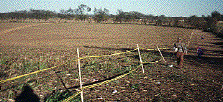
|
SPRING HILL, TENNESSEE
From a rise, you are looking along the spectator
line towards the tree-line. It marked roughly the two-thirds
point for the spectator line at the battle of Franklin in
1995. The area beyond the trees was the focus of many human
wave assaults against the large Federal defensive works--not
much of which could have been seen from this position.
|


